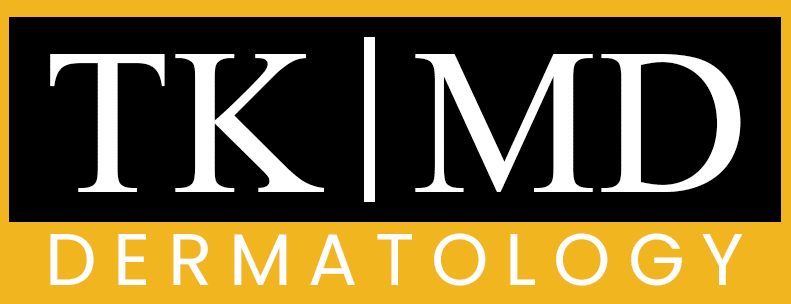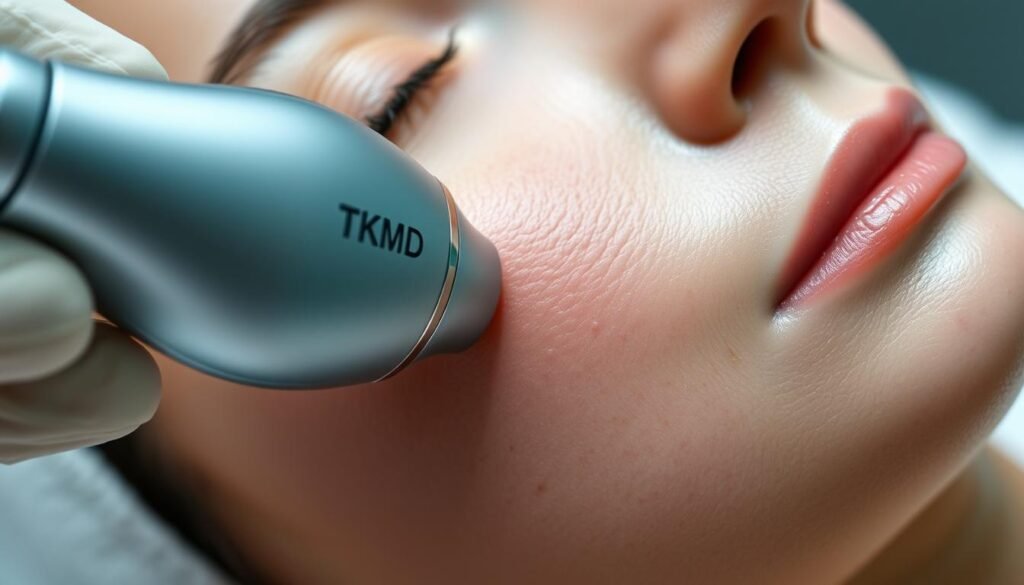Acne scarring can be a lasting reminder of a past skin condition that has left its mark, not just on the skin but also on one’s self-esteem. The emotional impact of acne scars can be significant, making it essential to find effective treatment options.
Acne scarring occurs after the visible resolution of deep inflammation, and it can happen regardless of the severity of acne. Fortunately, advancements in dermatological treatments have led to the development of minimally invasive procedures like RF microneedling, which combines traditional microneedling with radiofrequency energy to enhance results.
This innovative treatment works by creating controlled micro-injuries in the skin while delivering radiofrequency energy to deeper layers, stimulating collagen production and skin renewal to improve the appearance of scars.
Key Takeaways
- RF microneedling is a revolutionary approach to treating acne scars.
- This treatment combines microneedling with radiofrequency energy for enhanced results.
- It stimulates collagen production and skin renewal to improve the appearance of scars.
- RF microneedling is effective across different skin types with minimal downtime.
- The procedure targets multiple layers of the skin for comprehensive scar remodeling.
Understanding Acne Scars and Their Impact
Acne scarring is a common concern for many, leading to both physical and emotional distress. Acne scars develop as a result of the skin’s healing process following inflammatory acne, with different types forming based on how the skin repairs itself.
Types of Acne Scars
Acne scars can manifest in two primary forms: atrophic and hypertrophic scars. Atrophic scars develop due to tissue loss, resulting in indentations in the skin, whereas hypertrophic scars appear raised. The main atrophic scars are ice pick, boxcar, and rolling scars.
| Scar Type | Description |
|---|---|
| Ice Pick Scars | Narrow, deep, and V-shaped depressions |
| Boxcar Scars | Wider depressions with defined edges |
| Rolling Scars | Wave-like depressions with sloping edges |
According to research, understanding the specific characteristics of each scar type is crucial for determining the most effective treatment approach (PMC4509584).
Psychological and Social Effects of Scarring
Beyond the physical manifestation, acne scars can have profound psychological impacts, including decreased self-esteem, social anxiety, depression, and reduced quality of life. Many individuals with acne scarring report feeling self-conscious in social situations, with studies showing correlations between facial scarring and higher rates of unemployment and social isolation.
The emotional burden of acne scarring often persists long after active acne has resolved, making effective treatment options crucial for both physical and psychological healing. By understanding the types of acne scars and their impact, individuals can seek appropriate treatments to alleviate their symptoms.
What is RF Microneedling for Acne Scars?
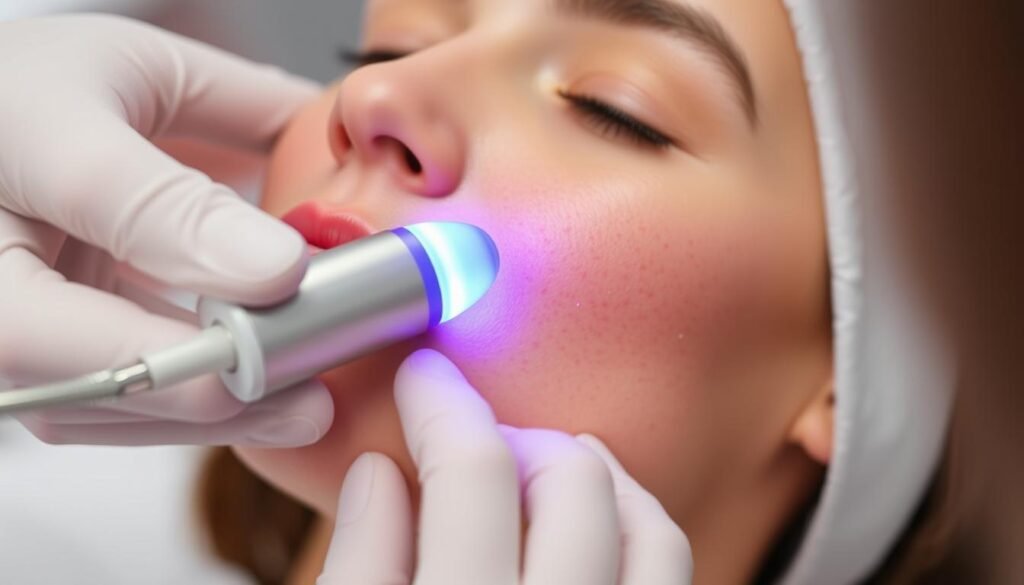
RF microneedling is a revolutionary treatment that combines the benefits of microneedling and radiofrequency energy to effectively address acne scars. This innovative approach has garnered significant attention in the dermatological community due to its potential to provide more comprehensive and lasting results compared to traditional microneedling alone.
The treatment utilizes a specialized microneedling fractional radiofrequency (RF) device equipped with fine, insulated needles that penetrate the skin at controlled depths while simultaneously delivering radiofrequency energy directly to the dermis. This dual-action mechanism not only stimulates collagen production but also promotes thermal remodeling, leading to improved skin texture and reduced appearance of acne scars.
The Science Behind RF Microneedling
The science behind RF microneedling involves the controlled delivery of radiofrequency energy to the dermis, triggering a robust healing response and enhanced collagen production. The device used in this treatment features a disposable tip with 49 gold-plated needles that are insulated along their length, ensuring precise energy delivery to the targeted area.
By adjusting both needle depth and energy levels, practitioners can customize the treatment based on the type and severity of acne scars, as well as individual skin characteristics. This flexibility allows for tailored treatment plans that cater to diverse patient needs.
How RF Differs from Traditional Microneedling
Unlike traditional microneedling, which relies solely on physical micro-injuries to stimulate collagen production, RF microneedling adds the dimension of thermal energy. This combination results in more comprehensive skin remodeling and improved outcomes for deeper scars.
Clinical studies have shown that the addition of radiofrequency energy to microneedling can enhance results by up to 60% compared to traditional microneedling alone for acne scar treatment. This significant improvement underscores the potential of RF microneedling as a superior treatment option for individuals seeking to address acne scars and rejuvenate their skin.
How RF Microneedling Works to Treat Acne Scars
Acne scars can be challenging to treat, but RF microneedling offers a promising solution by utilizing a dual-action approach that targets both the surface texture and deeper dermal structures simultaneously.
RF microneedling treats acne scars through a combination of mechanical microneedling and the delivery of radiofrequency energy. The microneedles create controlled micro-injuries in the skin, triggering the body’s natural wound healing response and initiating the three-phase collagen induction process: inflammation, proliferation, and remodeling.
The Collagen Induction Process
During the inflammation phase, platelets release growth factors that attract fibroblasts to the treatment area, setting the stage for new collagen formation. The proliferation phase involves the production of new collagen (types I and III) and elastin fibers, which gradually replace the damaged scar tissue with healthier skin structure.
| Phase | Process | Outcome |
|---|---|---|
| Inflammation | Release of growth factors | Attracts fibroblasts |
| Proliferation | Production of new collagen and elastin | Replaces damaged scar tissue |
| Remodeling | Collagen remodeling | Improved skin texture |
Radiofrequency Energy’s Role in Scar Remodeling
Radiofrequency energy delivered through the needle tips generates controlled heat in the dermis (approximately 65-75°C), causing immediate collagen contraction and long-term collagen remodeling. This thermal energy disrupts abnormal collagen fibers present in acne scars, allowing them to be replaced with new, properly organized collagen during the healing process.
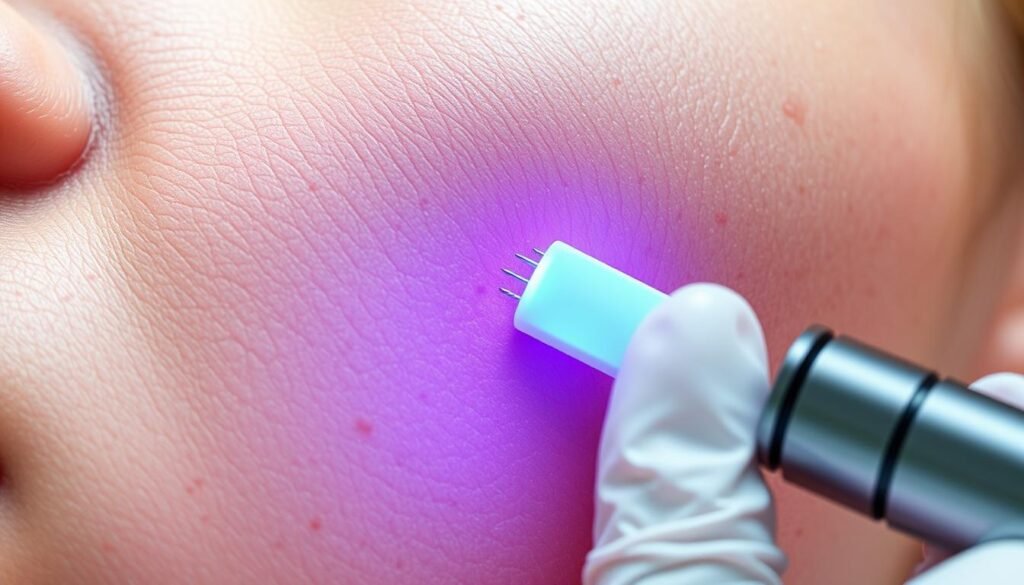
The combination of mechanical and thermal stimulation creates a more comprehensive remodeling effect that can address various scar types, including deep, atrophic scars that are typically difficult to treat. The controlled depth of needle penetration allows practitioners to target specific scar depths, customizing treatment to address individual scar characteristics.
Benefits of RF Microneedling for Acne Scarring
RF microneedling has emerged as a highly effective treatment for acne scarring, offering numerous benefits for patients seeking to improve their skin’s appearance. This advanced dermatological treatment has gained popularity due to its efficacy across various skin types and scar severities.
The advantages of RF microneedling for acne scarring are supported by clinical data. Studies using the Goodman and Baron Global qualitative Acne Scarring System have shown significant improvement in patients with moderate to severe acne scars. For instance, in patients with Grade 4 scars, 85.71% showed improvement by 2 grades, and 14.28% by 1 grade. Similarly, for those with Grade 3 scars, 76.47% improved by 2 grades, and 23.52% by 1 grade.
Effectiveness for Different Scar Types
RF microneedling is effective for multiple types of acne scars. Rolling and boxcar scars show particularly impressive results, while even the more challenging ice pick scars demonstrate noticeable improvement. The treatment’s ability to customize needle depth and energy settings allows for personalized treatment plans tailored to specific scar characteristics.
Advantages for Various Skin Types and Tones
Unlike some laser treatments that carry higher risks for darker skin tones, RF microneedling is safe and effective across all Fitzpatrick skin types (I-VI). This makes it an inclusive option for diverse patient populations. The risk of post-inflammatory hyperpigmentation is significantly lower with RF microneedling, especially for patients with skin types IV-VI.
Additional benefits of RF microneedling include minimal downtime, with most patients returning to normal activities within 24-48 hours. The treatment provides gradual, natural-looking improvement that continues to develop over 3-6 months as new collagen forms. Beyond scar improvement, patients often report reduced pore size, improved skin texture, and a general rejuvenating effect on the skin.
The RF Microneedling Procedure: What to Expect
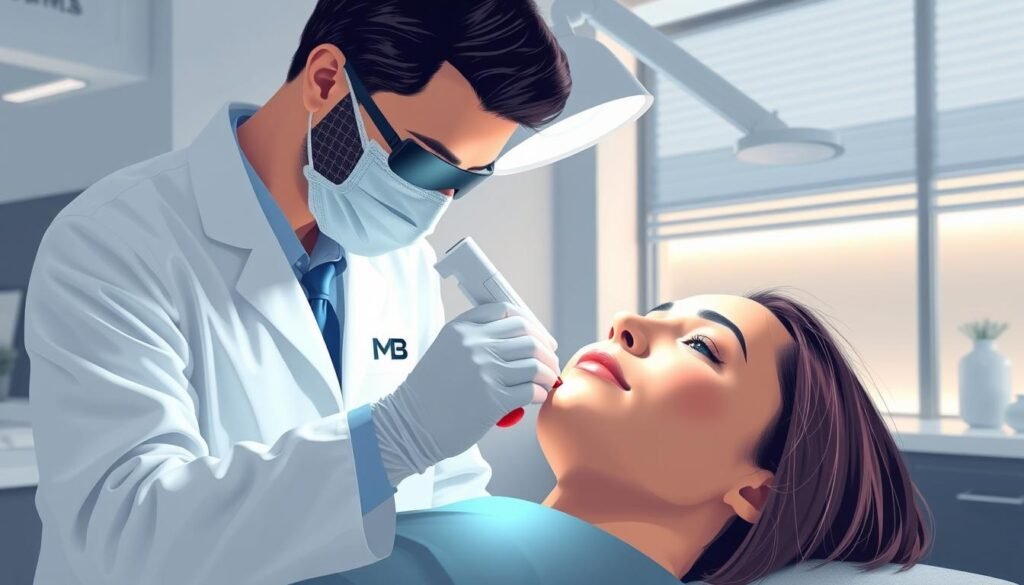
For those looking to address acne scars, knowing what to expect from the RF microneedling procedure can alleviate concerns. RF microneedling is a sophisticated treatment that requires careful preparation and aftercare to achieve optimal results.
Pre-Treatment Preparation
Before undergoing RF microneedling, patients typically have a consultation with a dermatologist or aesthetic specialist to assess their acne scars and determine if they’re suitable candidates for the procedure. Pre-treatment preparation often includes avoiding certain medications and supplements that can increase bleeding risk for 1-2 weeks before treatment, and discontinuing retinoids and other potentially irritating skincare products 3-5 days prior.
During the Treatment Session
On the day of treatment, the procedure begins with thorough cleansing of the skin followed by application of topical numbing cream for 30-60 minutes to ensure comfort during the session. The provider uses the RF microneedling device to make multiple passes over the treatment area, adjusting needle depth and energy settings based on the specific scar characteristics and location.
Post-Treatment Care
Immediately after treatment, the skin appears red and may feel warm, similar to a sunburn, with some patients experiencing minor pinpoint bleeding or mild swelling. Post-treatment care includes avoiding sun exposure, using gentle cleansers, applying recommended healing serums, and diligent use of broad-spectrum sunscreen to protect the healing skin. Most patients can resume normal activities within 24-48 hours, though redness may persist for 2-3 days.
Recovery and Results Timeline
For those considering RF Microneedling to treat acne scars, understanding the treatment’s aftermath and the timeline for visible improvements is essential. RF Microneedling is a minimally invasive procedure that stimulates collagen production and promotes skin rejuvenation.
Immediate Post-Treatment Effects
Immediately following RF Microneedling treatment, patients typically experience redness, mild swelling, and a sensation similar to a sunburn, which generally subsides within 24-48 hours. Some patients may notice tiny scabs or grid-like patterns where the needles penetrated the skin, resolving naturally within 3-5 days as part of the normal healing process.
Short-Term Healing Process
The short-term healing process involves an initial inflammatory response lasting 1-3 days, followed by a proliferative phase where new cells begin to form and the skin starts to feel smoother. Most visible side effects resolve within the first week, though some patients may experience prolonged redness or minor bruising that can last up to 10 days, particularly in sensitive areas.
| Timeframe | Healing Process | Visible Effects |
|---|---|---|
| 1-3 days | Initial inflammatory response | Redness, swelling |
| 3-5 days | Resolution of scabs/grid-like patterns | Gradual improvement |
| 1-2 weeks | Proliferative phase | Smoother skin, reduced redness |
Long-Term Results and Improvements
Results from RF Microneedling develop gradually, with initial improvements in skin texture and tone becoming noticeable around 2-3 weeks after treatment as surface healing completes. The most significant improvements in acne scars typically become visible 4-6 weeks after treatment as new collagen forms and remodels the skin’s structure. For more detailed information on when to expect results, visit Pure Medical Spa.
Long-term results continue to develop for up to 6 months following the final treatment session. Most patients require a series of 3-4 treatments spaced 4-6 weeks apart to achieve optimal results. Maintenance treatments may be recommended every 12-18 months to sustain and enhance the results.
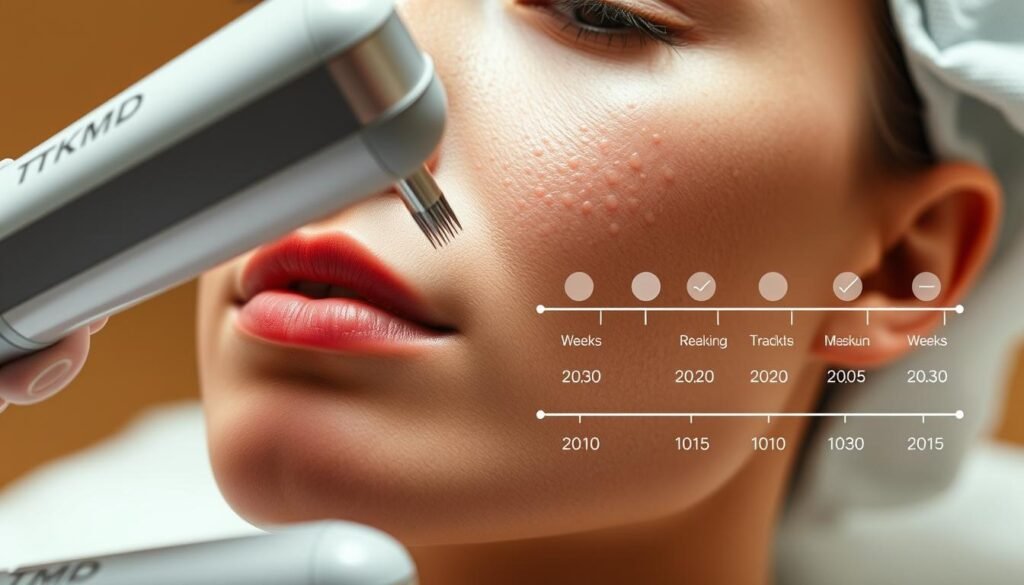
Clinical Evidence Supporting RF Microneedling
Clinical evidence supporting the use of RF microneedling for acne scars has been increasingly robust. Numerous studies have investigated the efficacy of this treatment, providing a comprehensive understanding of its benefits and limitations.
Research Studies and Their Findings
Several research studies have demonstrated the effectiveness of RF microneedling in treating acne scars. For instance, a study using Goodman and Baron’s Global quantitative Acne Scarring System found that 58% of patients achieved moderate improvement, 29% minimal improvement, 9% good improvement, and 3% very good improvement following RF microneedling treatment. Another study by Ramesh et al. treated facial acne scars of 30 subjects with a matrix tunable radiofrequency device and observed significant improvements in scar appearance.
A comparative analysis of RF microneedling and traditional microneedling has shown that the addition of radiofrequency energy results in approximately 60% greater improvement in acne scar appearance. This is supported by histological studies that confirm significant increases in collagen and elastin production after RF microneedling treatment.
| Study | Number of Patients | Treatment Outcome |
|---|---|---|
| Goodman and Baron | N/A | 58% moderate improvement, 29% minimal improvement |
| Ramesh et al. | 30 | 10-50% improvement at 2 months, 20-70% at 6 months |
| Gold et al. | 13 | 67-92% patient satisfaction |
Patient Satisfaction Rates
Patient satisfaction rates following RF microneedling treatment for acne scars have been consistently high. Research by Gold et al. involving patients with mild to moderate acne scars treated with bipolar fractional radiofrequency showed that 67-92% of patients were satisfied with their results. Long-term follow-up studies indicate that improvements are maintained for 1-2 years post-treatment, with some patients experiencing continued improvement even after the treatment series is complete.
Key findings from patient satisfaction surveys include:
- 70-90% of patients would recommend the procedure to others or undergo it again themselves.
- Significant improvements in acne scar appearance are observed across various study populations.
- RF microneedling is safe and effective for patients with darker skin types (Fitzpatrick IV-VI).
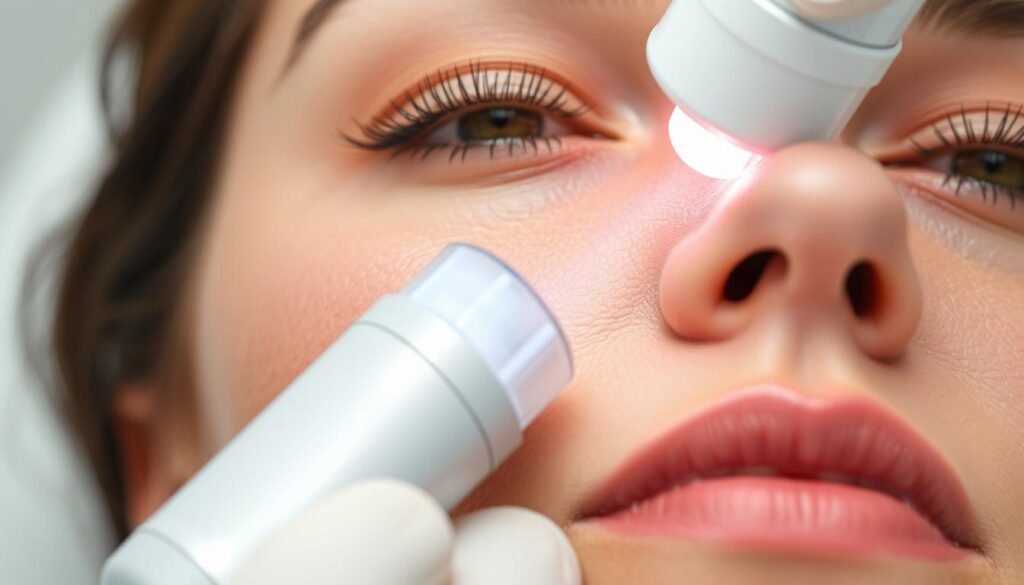
RF Microneedling vs. Other Acne Scar Treatments
When it comes to treating acne scars, RF microneedling stands out as a highly effective option. Its efficacy and safety profile make it a popular choice among patients and practitioners alike. To understand its advantages fully, it’s essential to compare RF microneedling with other common treatments for acne scars.
Comparison with CO2 Laser Therapy
CO2 laser therapy is a well-established treatment for acne scars, known for its ability to provide dramatic results in a single session. However, it comes with significant downtime, typically ranging from 7 to 14 days, and a higher risk of side effects such as hyperpigmentation, especially in individuals with darker skin tones. In contrast, RF microneedling offers comparable efficacy with less downtime (1-3 days) and a lower risk of hyperpigmentation (4-8% vs 20-30% for CO2 laser).
Comparison with Chemical Peels and Dermabrasion
Chemical peels and dermabrasion are other treatments used for acne scars. Chemical peels primarily address superficial issues through controlled exfoliation but lack the deeper remodeling capabilities of RF microneedling. Dermabrasion physically removes the epidermis and upper dermis, whereas RF microneedling preserves the epidermis while stimulating deeper remodeling, resulting in shorter recovery times and lower risks of permanent pigmentation changes.
Comparison with Traditional Microneedling
Traditional microneedling creates micro-channels in the skin to stimulate collagen production but lacks the thermal component of RF microneedling. Studies have shown that the addition of radiofrequency energy in RF microneedling improves results by approximately 40-60% for moderate to severe acne scars. While traditional microneedling requires more treatment sessions (6-8 vs 3-4 for RF microneedling), it is generally more budget-friendly per session.
Ideal Candidates and Treatment Planning
The effectiveness of RF microneedling for acne scars depends on selecting the right patients and tailoring the treatment plan. RF microneedling has emerged as a highly effective treatment for various types of acne scars, particularly for those who have not responded well to topical treatments or less invasive procedures.
Who Should Consider RF Microneedling
RF microneedling is particularly beneficial for individuals with moderate to severe atrophic acne scars. Patients with rolling or boxcar scars tend to see significant improvements, although those with ice pick scars may also benefit with appropriate device settings. The treatment is suitable for all skin types (Fitzpatrick I-VI), making it an excellent option for patients with darker skin tones who may be at risk of hyperpigmentation with certain laser treatments.
- Individuals with moderate to severe atrophic acne scars
- Patients who have not responded adequately to topical treatments or less invasive procedures
- Those with rolling or boxcar scars, and potentially ice pick scars with customized treatment
- All skin types, including darker skin tones
Factors Affecting Treatment Success
Several factors significantly impact the success of RF microneedling treatment. These include the patient’s age, with younger patients typically responding better due to their higher collagen-producing capacity. The age of the scar, with newer scars responding better than older ones, and the type of scar are also crucial. The treatment protocol, including the number of sessions (typically 3-4), the interval between treatments (usually 4-6 weeks), and device settings, should be customized based on individual scar characteristics and skin type.
| Factor | Description | Impact on Treatment |
|---|---|---|
| Patient Age | Younger patients have higher collagen-producing capacity | Better response to treatment |
| Scar Age | Newer scars are more responsive | Improved treatment outcomes |
| Scar Type | Different scars respond differently to RF microneedling | Customized treatment protocols are essential |
| Treatment Protocol | Number of sessions, interval between treatments, device settings | Directly influences treatment success |
Patient compliance with pre- and post-treatment care instructions is also vital. This includes sun protection, avoiding certain skincare ingredients, and following proper wound care to minimize side effects and optimize outcomes.
Conclusion
RF microneedling has emerged as a groundbreaking treatment for acne scars, offering a minimally invasive solution with significant benefits. This innovative approach combines the physical stimulation of microneedling with the thermal effects of radiofrequency energy to promote collagen remodeling and skin renewal.
Clinical studies have consistently shown that RF microneedling provides meaningful improvement for moderate to severe acne scars, with most patients experiencing at least one grade of improvement on standardized scarring scales. The treatment’s versatility makes it suitable for all skin types, including darker skin tones that may be at higher risk for complications with other energy-based treatments.
While a series of RF microneedling treatments may be necessary, the results continue to develop for months after the final session. The safety profile of RF microneedling is favorable, with most side effects being temporary and mild. For optimal results, patients should seek treatment from qualified providers who can customize the procedure based on individual scar characteristics and skin needs.
